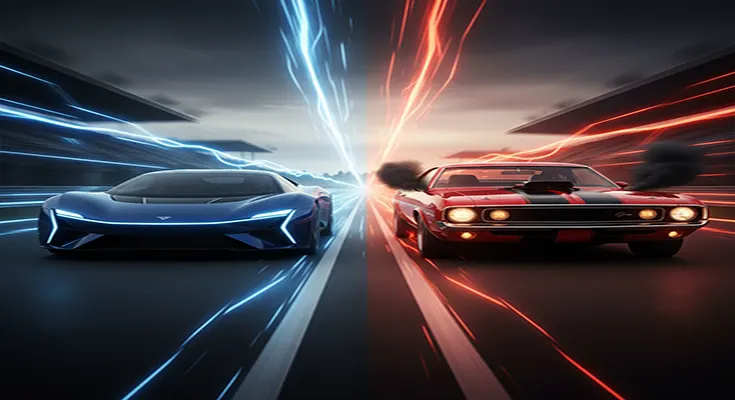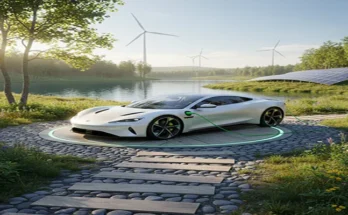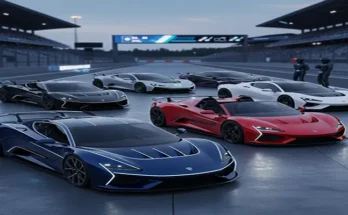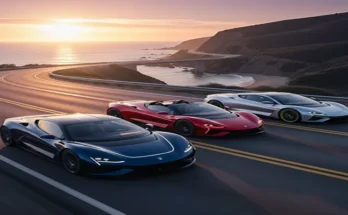The world of high-performance driving is undergoing a revolution. The classic roar of a naturally aspirated V8 is now competing with the near-silent, brutal acceleration of an electric motor. The question is no longer “Can electric vehicles (EVs) be sports cars?” but rather, “How do they change the definition of a sports car?”
Comparing high-performance EVs, like the Porsche Taycan or Lucid Air Sapphire, to iconic gasoline-powered counterparts, such as a Porsche 911 or a Ferrari, reveals fundamental differences in performance delivery, handling, and ownership experience.
The Acceleration Showdown: Torque is King
The most dramatic difference between a sports EV and a traditional gas car is evident in the 0-to-60 mph sprint.
| Feature | Sports Electric Vehicle (EV) | Traditional Gas Car (ICE) |
| Torque Delivery | Instant – Maximum torque available from 0 RPM. | Delayed – Requires the engine to build up RPM (typically 3,000–5,000 RPM) to reach peak torque. |
| Transmission | Single-speed (or two-speed) gear reduction. No shift delay. | Multi-speed transmission (6 to 10 gears). Acceleration is momentarily interrupted by gear shifts. |
| Result | Unmatched off-the-line acceleration. EVs often achieve the fastest production car 0-60 mph times. | Incredible acceleration after the engine is in its power band, with a dramatic, revving climb to speed. |
The EV Advantage: An electric motor is mechanically simple, delivering its maximum force—or torque—the instant the accelerator is pressed. This instantaneous and relentless thrust allows high-performance EVs to consistently out-accelerate nearly all traditional supercars from a standstill.
The Gas Car Advantage: The multi-gear setup and higher power curve of an Internal Combustion Engine (ICE) car often allows it to achieve and maintain a higher top speed over a sustained period, though this gap is rapidly closing. The visceral experience—the sound, vibration, and gear shifts—remains a unique draw for enthusiasts.
Handling and Chassis Dynamics
Performance isn’t just about straight-line speed; it’s about cornering, balance, and stability. Here, the unique architecture of the EV fundamentally changes the car’s dynamics.
- Center of Gravity: Electric sports cars have their massive, heavy battery pack mounted low in the chassis, spanning the floor of the vehicle. This results in an extremely low center of gravity (CoG), which dramatically reduces body roll and improves stability during high-speed cornering, making the car feel glued to the road.
- Weight Penalty: However, that same battery pack makes the EV significantly heavier than a comparable gas car. While the low CoG mitigates this in turns, the sheer mass requires larger brakes and specialized tire compounds, and it can affect the agility and ‘lightness’ felt in rapid direction changes.
- Aesthetics vs. Aero: EVs are often designed to be extremely aerodynamic to maximize their range, leading to sleek, low-drag shapes. Gas sports cars can sometimes prioritize aggressive styling and downforce elements, leading to higher drag but greater high-speed grip.
The Ownership Trade-offs: Range and Refueling
The performance comparison is only half the story; daily usability and long-distance travel introduce different challenges.
| Consideration | Sports EV | Traditional Gas Car |
| Refueling Time | 20–40 minutes for a high-speed DC fast charge (20% to 80%). | 2–5 minutes for a full tank. |
| Infrastructure | Public charging networks are rapidly growing but can be inconsistent or scarce in remote areas. Home charging is convenient for daily use. | Gas stations are ubiquitous and readily available everywhere. |
| Maintenance | Lower—Fewer moving parts (no oil, spark plugs, timing belts). Regenerative braking reduces brake wear. | Higher—Requires frequent oil changes, fluid flushes, and engine component maintenance. |
| Energy Cost | Generally cheaper to “refuel” electricity at home than buying premium gasoline. | Cost is highly volatile and subject to global oil market prices. |
| Emissions | Zero tailpipe emissions. Overall environmental impact depends on the source of electricity generation. | Significant tailpipe emissions (CO2, NOx) contribute to air pollution and climate change. |
A New Era of Performance
Sports electric vehicles represent a paradigm shift. They leverage the instant power of electric motors to deliver a new level of acceleration that traditional gas cars struggle to match. However, the legacy ICE sports car retains the advantage of fast refueling, a proven long-distance range, and the cherished, audible theater of an engine’s roar.
As battery technology advances to reduce weight and improve range, and as charging infrastructure expands, the performance gap will continue to widen in favor of the EV. The future of the sports car will likely be defined by a silent speed that is as potent as it is immediate.





